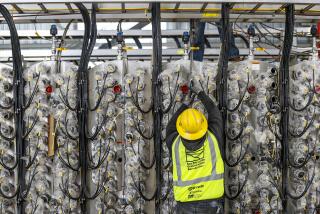Lockheed Can Send Fumes From Toxic Soil Into Air : Environment: Defense firm gets AQMD permission as part of Superfund cleanup. Release of potential carcinogens sows anger.
BURBANK — Regional air pollution control officials have given the Lockheed Corp. permission to pump up to 44 pounds a day of vapors containing potentially cancer-causing substances into the air as part of the massive Superfund effort to clean up contaminated soil, officials said Monday.
The defense firm has been granted preliminary approval by the South Coast Air Quality Management District to operate about 200 wells next year that will remove volatile organic compounds from contaminated soil and release them into the atmosphere. The project is aimed at meeting federal Environmental Protection Agency orders to remove the contaminants before they poison underground water sources.
The proposed “vapor extraction system,” as it is known, will “employ the best available control technology for controlling air pollution” and there is less than one chance in 100,000 that anyone would actually develop cancer from breathing the exposed air, according to the AQMD.
Nonetheless, it has raised the ire of nearby residents who worry about the potential health risks and a drop in their property values. Some have asked how carcinogens could be any safer in the air than in the ground.
Al Iverson, 76, lives across the street from a vacant lot at 1705 Victory Place, where Lockheed’s former B-1 plant was situated and where the proposed system will be built.
“We’re quite perturbed by not knowing how safe this thing is and how long it will last,” he said. “Nobody told us it was contaminated soil. . . . You can hardly sell a house here now because no one wants to buy it.”
About 50 angry residents who held a meeting during the weekend to stop the project are thinking of taking their complaints to the Burbank City Council soon.
But even if council members wanted to side with residents, Burbank Mayor Bill Wiggins said there is little city officials can do.
“The fact of the matter is the city has no jurisdiction over this because it’s an issue between Lockheed and the AQMD,” Wiggins said, adding that he would like Lockheed to release a detailed description of the project.
EPA officials said the issue is being left to the AQMD.
Earlier this month, the AQMD notified residents near the B-1 plant of its intention to issue Lockheed a permit to operate the wells.
One reason given by the agency for doing so was that the project complies with regulations governing air pollution control.
“Over the years, things have gotten spilled into the ground and we now have this, for a lack of a better term, toxic waste dump,” said Bill Milner, an AQMD engineer.
If nothing is done, he said, “there’s going to be a greater long-term health risk” from contaminated water. “That’s the bottom line.”
According to an AQMD analysis, chemicals such as carbon tetrachloride, chloroform, methylene chloride and trichloroethylene used to de-grease airplane parts before painting them have seeped into the ground under the former B-1 plant site.
One goal of the proposed system, Lockheed officials say, is to stop solvents in the soil from reaching the already tainted ground water that has shut down Burbank’s municipal water wells.
“We’re doing everything we can to meet the requirements of the (AQMD),” said Lockheed spokesman Keith Mordoff.
The AQMD estimates that the project will cost about $13 million, but Lockheed officials could not confirm that figure Monday.
With a vapor extraction system, newly built wells would extract vapors from the contaminated soil and filter them through a controlling system.
For every 100 pounds of vapor extracted, Milner said, two pounds will be released into the air from a 50-foot tower while the rest will be piped into a storage tank for disposal at a later date.
Before the system can be put in place, however, Lockheed must present its proposal to the Burbank Planning Board to obtain a conditional-use permit to operate the tower.
Despite the tension between some homeowners and project officials, other residents near the vacant lot remain unfazed.
“There are so many carcinogens in the air we breath and, yes, in the water we don’t drink,” said Noel Hobson, 53, a graphic designer living a few blocks away.
More to Read
Sign up for Essential California
The most important California stories and recommendations in your inbox every morning.
You may occasionally receive promotional content from the Los Angeles Times.










